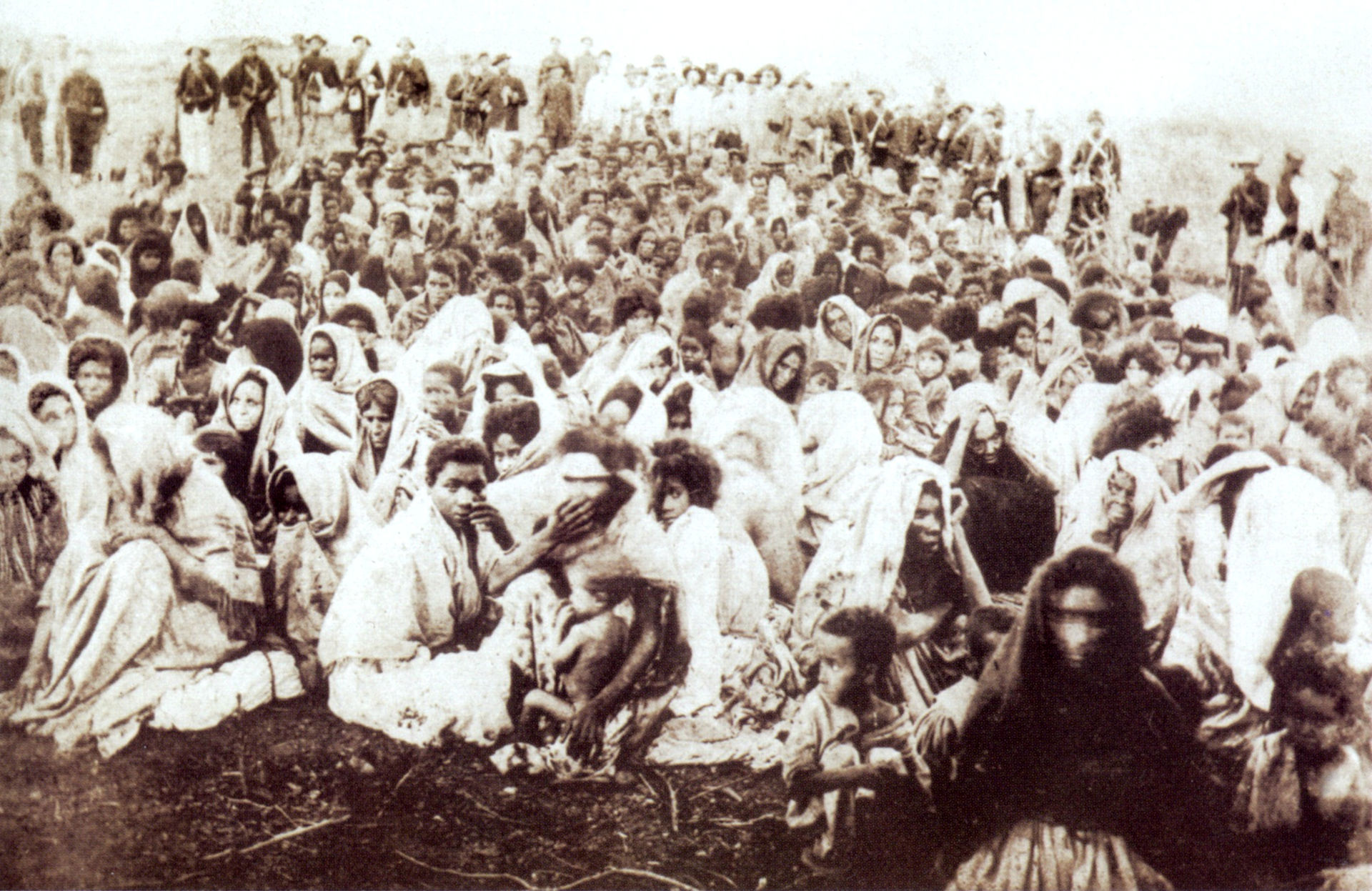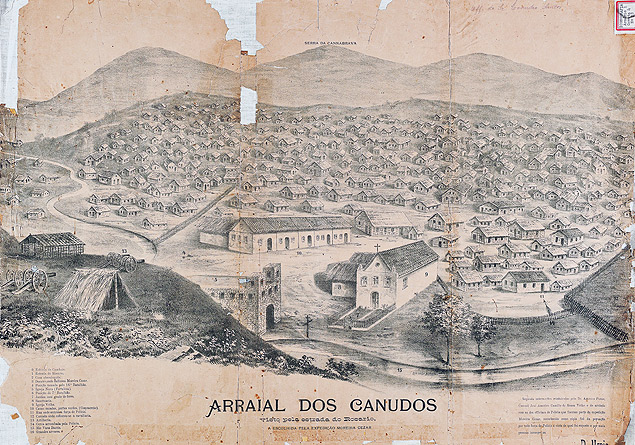State Violence and the Canudos Massacre in Brazil

In April of 1897, General Artur Oscar de Andrade Guimarães began preparing for an expedition that would carry he and an army of Brazilian soldiers from the coast of Rio de Janeiro into the backlands of the state of Bahia. He had been tasked by the national government in Rio with destroying Canudos, a settlement in the interior of Bahia that had existed since 1893 and that had already successfully defeated three military campaigns that had been sent by the Brazilian government throughout the decade.
Canudos came into being through the itinerant sermons of one Antônio Conselheiro, a spiritualist who went from town to town in the interior of Bahia fixing dilapidated churches and doing other small jobs that impressed poor commoners in the early 1890s. The Brazilian Republic had only been established in 1889, and though the new national government pursued an ambitious project to modernize the country, the bulk of their work remained concentrated on coastal cities like Rio, or other major metropolitan areas like São Paulo. Thus, with so little attention given to development in the interior of the country, the presence and labor of Conselheiro did not go unnoticed—for many who lived in the interior he represented a stark contrast to the neglect that the impoverished majority experienced through the modernizing policies and projects of the national government. Furthermore Conselheiro himself inveighed against the hypocrisy and illegitimacy of the new regime, lending further credence to the notion that those who had thus far been neglected by the state could in fact do just fine without being beneficiaries of the state’s modernizing impetus.

As the numbers of Conselheiro’s followers grew, they became an easy target, a symbol that the national elite could hold up to the rest of the country as an example of what resistance to modernity looked like: a motley collection of mixed-race paupers who were too ignorant at best and too deranged at worse to know what was best for them. Thus, although slavery in Brazil had only been abolished in 1888—bestowing on Brazil the unenviable distinction of being the last country in the Americas to end human bondage—by 1893 the government had already identified a new “internal enemy,” a new collection of people “lacking reason” and accordingly expended much time, energy, and resources in efforts to destroy this “embarrassment” that “was overwhelmingly populated by gente de cor [people of color].”
General Artur Oscar de Andrade Guimarães’s campaign was a success for the national government in one sense—he and his army of soldiers successfully defeated Canudos and brought the settlement to an end. Yet in the process an estimated 15,000- 30,000 people lost their lives. Conselheiro himself died of dysentery, but invading soldiers killed most of the inhabitants of Canudos outright. The destruction of the settlement and the high death toll not only shined light on the modern artillery of the Brazilian army, but also caused some journalists and writers such as Euclides da Cunha (a writer whose 1902 account of Canudos remains indispensible, even if thoroughly racist) to raise a critical question: was it the inhabitants of Canudos who were deranged or was it the national government that was mad? Who had lost their reason her—the poor who endeavored to live off the land and in accordance with a brand of stoic, wandering Catholicism or a government so obsessed with national image that they openly endorsed massacre (a recurring refrain to justify the destruction of Canudos was that it made Brazil look backwards to the outside world).
Da Cunha’s concern was in all likelihood stimulated by two facts. Firstly, though the Brazilian government had authorized the national army to make not one, not two, not three, but four assaults on Canudos, the event was registered in papers and thus in popular discourse as the War of Canudos or the Canudos Rebellion. Thus the national government was savvy in its propaganda tactics, and an entire settlement that never moved to topple the government and that in fact worked towards isolationism became legible to Brazilian readers only as a physical threat to their security. English translators were in fact complicit in uncritically passing on this propaganda to US scholars of Brazil, as da Cunha’s narrative of Canudos- which was published in Portuguese as Os Sertões (the Backlands)- became translated as Rebellion in the Backlands in the 1957 appearance in English. Secondly, when the army recovered the corpse of Antonio Conselheiro it was beheaded and the cranium was sent to the Medical Faculty of Bahia for psychiatric and craniological examination. The head of the investigation, Dr. Raimundo Nina Rodrigues, declared that Conselheiro was not only mad but suffered from a specific form of madness: delirium of persecution. Thus when da Cunha posed the question of whether the state itself was mad, he was in fact interrupting a one-sided characterization of the movement in which newspapers, politicians, and medical experts employed overlapping discourses that left little room to see Conselheiro or his followers within the light of reason.

With all of the focus on Conselheiro both during and since Canudos, little sustained attention has been given to how the reading of Conselheiro as mentally ill, justified the execution of his large non-white following. We know that they were characterized as against the national government, and historians have often pointed out the ways that Canudos was a refuge for people who felt isolated from national policies. However, there is another story that pulses underneath this narrative, one that is tethered to the fact that Canudos appeared in the immediate aftermath of slavery and that begs the question of whether or not Canudos should be thought of as an anti-modern settlement, or whether it can be better understood as a settlement informed by and extending the logic of quilombo and maroon communities.
Pictures can tell us much, and the headline photo to this post has been often used to give readers a visual descriptor of those who chose to flee to and live in Canudos. The collection of black and brown women and children turned toward the camera stir up feelings of devastation but also questions related to vulnerability. Many who came to Canudos were effectively not citizens of the new republic—in fact, in a sense they were fugitives from the new republic who found sanctuary in Canudos. Were the successive raids on Canudos only driven by the state’s desire to turn “idle” hands back to productive farm work that would contribute to modernization? Or did Canudos not only spark sentiments of embarrassment for the elite but also rekindle fears of runaway slave settlements toppling the regime? Given that the slave trade to Brazil had only ended in 1850, how many of these black and brown individuals were effectively refugees or children of refugees in 1897? Was Canudos not simply an escape from forms of coercive labor and dehumanization that continued after slavery, but also a safe haven for those who might have been targeted for deportation as the new republican government became more attached to expressions of nationalism?
While there are no easy or transparent answers to such questions, we live in times where these are the kinds of questions that need to be asked by those of us working across the terrains of rebellion, revolution, and insurgency. Thus it is not just the issue of renaming Canudos from a rebellion to a massacre that is important, but also piecing together a genealogy of state violence that invents the insurgent, imagines the rebellion, and constructs fugitivity from persecution as not only a threat to private property but as a threat to national sovereignty as well.
Copyright © AAIHS. May not be reprinted without permission.